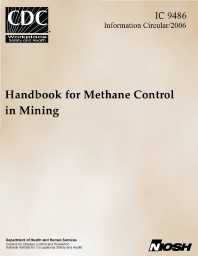Mining Publication: Handbook for Methane Control in Mining
Original creation date: June 2006
This handbook describes effective methods for the control of methane gas in mines and tunnels. It assumes the reader is familiar with mining. The first chapter covers facts about methane important to mine safety, such as the explosibility of gas mixtures. The second chapter covers methane sampling, which is crucial because many methane explosions have been attributed to sampling deficiencies. Subsequent chapters describe methane control methods for different kinds of mines and mining equipment, primarily for U.S. coal mines. These coal mine chapters include continuous miners and longwalls, including bleeders. Coal seam degasification is covered extensively. Other coal mine chapters deal with methane emission forecasting and predicting the excess gas from troublesome geologic features like faults. Additional coal chapters contain methane controls for shaft sinking and shaft filling, for surface highwall mines, and for coal storage silos. Major coal mine explosion disasters have always involved the combustion of coal dust, originally triggered by methane. Thus, a chapter is included on making coal dust inert so it cannot explode. Methane is surprisingly common in metal and nonmetal mines around the world, as well as in many tunnels as they are excavated. Accordingly, a chapter is included on metal and nonmetal mines and another on tunnels. Proper ventilation plays the major role in keeping mines free of hazardous methane accumulations. The ventilation discussed in this handbook, except for the chapter on bleeder systems, deals only with so-called face ventilation, i.e., ventilation of the immediate working face area, not ventilation of the mine as a whole. The omission of whole-mine ventilation was necessary to keep this handbook to a reasonable size and because a huge amount of excellent information is available on the subject.
Authors: FN Kissell
Information Circular - June 2006
NIOSHTIC2 Number: 20030254
Pittsburgh, PA: U.S. Department of Health and Human Services, Public Health Service, Centers for Disease Control and Prevention, National Institute for Occupational Safety and Health, DHHS (NIOSH) Publication No. 2006-127, Information Circular 9486, 2006 Jun; :1-184
See Also
- Development and Application of Reservoir Models and Artificial Neural Networks for Optimizing Ventilation Air Requirements in Development Mining of Coal Seams
- Evaluation of the Relative Importance of Coalbed Reservoir Parameters for Prediction of Methane Inflow Rates During Mining of Longwall Development Entries
- Guidelines for the Control and Monitoring of Methane Gas on Continuous Mining Operations
- Investigation of Methane Occurrence and Outbursts in the Cote Blanche Domal Salt Mine, Louisiana
- Methane Content of Gulf Coast Domal Rock Salt
- Modeling and Prediction of Ventilation Methane Emissions of U.S. Longwall Mines Using Supervised Artificial Neural Networks
- Remote Methane Sensors
- Reservoir Modeling-Based Prediction and Optimization of Ventilation Requirements During Development Mining in Underground Coal Mines
- Reservoir Rock Properties of Coal Measure Strata of the Lower Monongahela Group, Greene County (Southwestern Pennsylvania), from Methane Control and Production Perspectives
- Ventilation of Longwall Faces
- Content source: National Institute for Occupational Safety and Health, Mining Program


 ShareCompartir
ShareCompartir
